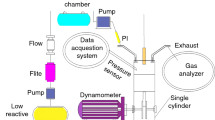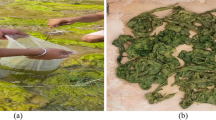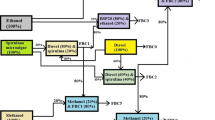Abstract
The basic objective of this article was to evaluate the effect of microalgae oil (MAO) blends on engine efficiency and pollution characteristics of a single cylinder variable compression direct-injection ignition compression motor running at 1500 rpm. The raw oil was acquired from microalgae manufacturing using a rowing pond with native algal communities. The good MAO was accomplished by transesterification technique and mixed with petrol in diverse proportions of B20 (20% MAO–90% diesel), B40 (40% MAO–80% diesel), B60 (60% MAO–70% diesel), B80 (80% MAO–20% diesel), and 100% quantity-based MAO. Their features have been validated based on ASTM standards. Investigational findings show that at B20, brake thermal efficiency, brake specific fuel consumption, and nitrogen oxides are optimal compared to other biodiesel blends.
Access provided by Autonomous University of Puebla. Download conference paper PDF
Similar content being viewed by others
Keywords
1 Introduction
Day to day increases the utilization of the fuel consumption and increases the demand of fuel. The fossil fuels are more effected to the environment and also human health. Ali and Hanna [1] evaluated the use of essential oils and refined carbohydrates as gas in diesel engines. The impact of oil preparing techniques such as transesterification, thermal decomposition, dilution, and micro-yeast fermentation on fuel characteristics and its consequent impact on gasoline engine efficiency was addressed. Ikwuagwu et al. [2] separated plant fuel from rubber (Heveabrasiliensis). Methyl ester was structured by transesterification using iron chloride as a liquid with an additional 6-molar quantity of methanol. Melvin et al. [3] manufactured rubber licorice root methyl esters. The acid content of oilseed oil was 35 mg KOH/g. Given the presence of elevated FFA, two-stage solvent extraction was used to decrease the FFA quantity of raw rubber seed oil. Atabani et al. [4] generated biofuel from Camelina sativa, known as misleading flax. It has a small content of FFA (1.0 wt.%) and elevated concentrations of unsaturated such as linolenic (38.4 wt.%), gondoic (16.8 wt.%), linoleic (14.3 wt.%) and hemp seed oil (14.3 wt.%). The unique properties of camelina oil methyl esters include 3 ℃ and −4 ℃ cloud point and pour point values. The direct-injection engine compression qualities fueled with biodiesel included cottonseed oil blends were evaluated by Bharadwaj et al. [5]. The testing evaluation involves three types of biodiesel and diesel seed oil used in cotton plants (10%, 15%, and 20% blends). Shrigiri et al. [6] discovered that brake thermal efficiency at peak loads is lowered by 5.91% and specific fuel consumption. Senthil Kumar et al. [7] in their work on the impact of octane oil resistance on combustion behavior with macroalgae oil-based dual-fuel engine discovered a decrease in combustion length in dual-fuel mode with eucalyptus oil with relatively higher brake fuel efficiency.
2 Biodiesel Preparation
Biofuel can be obtained from vegetable oils or edible oils, non-food vegetable oils or inedible oil, animal fats and surplus or used vegetable oils. Methyl, ethyl, and butyl esters generated through the transesterification of vegetable oils are the most prevalent kinds of biofuels. Therefore, the generally successful application of vegetable oils as biodiesel fuels can be called the ester of vegetable oils.
Microalgae oil manufacturing began from microalgae growing using a gravel pond with indigenous algal populations, with Desmodesmus being the primary plant with other species including Scenedesmus acumunatus, Klebsormidium, Dictyosphaerium, and other small fraction trees. Desmodesmus as the primary ratio of individuals varies depending on the season but can reach up to 24% of the complete population. The microalgae were collected and sent to a wastewater centrifuge and a tank dryer for a second drainage phase once getting HTL therapy. Algae production is a simple method that disposed of developing the coral by supplying the needed inputs for respiration, harvesting, soil sampling, and extracting oil. The algae cells carry the energy of photons that converts the metal oxides of CO2 and water into glucose and oxygen. The grains are ultimately transformed within the algae organs into complicated protein, fats, nutrients, and fats. To remove precious lipids, a series of measures must be taken to isolate algae cells and oil [8, 9].
The criterion method begins with centrifuges, filtration, or flocculation techniques to separate the algae biomass from the water broth in the dewatering stage. Centrifuges acquire energy by spinning its soup of algae-water so that water goes away from either the algae bodies. Flocculation involves making algae cells out of location so they can be easily concentrated and removed. When the algae cells are collected, the oil must be divided from the shells. The oil can then be converted to biofuel, jet fuel, ethanol, synthetic fuel, or other substances. The flash points and fire points were measured using flash point tester. The calorific value was evaluated using a fast point test [10, 11]. The amount of Cetane was evaluated using bomb calorimeter. Table 1 shows the fuel characteristics (Fig. 1).
3 Experimental Setup
The experimental setup used for the current experimental investigations comprises of an engine with dynamometer, exhaust meter for exhaust gas analyzer. The test engine used is 4S1C, making Kirloskar’s water-cooled, direct-injection ignition compression engine with eddy current dynamometer. This device can be met with greater pressures and can also be used widely in the agricultural and industrial industries. This machine is therefore chosen to carry out studies. Furthermore, needed changes can be produced readily on the piston needed for the current job. The density of the smoke is evaluated with a Bosch smoke meter. A gas analyzer is connected to the engine to evaluate the pollutants in the exhaust gas. This analyzer is used to evaluate three major exhaust emissions, i.e., CO, NOx, and uHC (Figs. 2, 3 and Table 2).
4 Results and Discussion
4.1 Brake Thermal Efficiency (BTE)
Changes in BTE with diesel loads and distinct advertisements for biodiesel fuels are shown in Fig. 4. The diesel fuel brake thermal efficiency showed 27.1% at elevated load and 11.56% at low load. It is observed BTE was increases with increases the load. As shown in Fig. 4, BTE of the methyl ester microalgae oil at 20% of the load was observed 10.27%, 9.39%, 9.25%, 8.29%, and 8.13% and high load was observed 25.7%, 24.6%, 22.63%, 21.65%, and 20.45%. With respective fuel blends MAO 20, MAO 40, MAO 60, MAO 80, and MAO 100. It is observed that the brake’s thermal efficiency was improved by raising the load. Experiment recognized diesel fuel consists of elevated BTE compared to biodiesel fuel. The primary cause of lowering in heat brake effectiveness is owing to the decreased heating value of biofuel relative with diesel. Brake thermal efficiency of methyl ester microalgae oil at MAO 20 was noted to a maximum extent than other combustion of fuels.
4.2 Brake Specific Fuel Consumption (BSFC)
The comparison of BSFC with load for diesel as well as biodiesel blends as shown in Fig. 5. BSFC of the diesel fuel was recorded 0.81 kg/kWh, 0.5 kg/kWh, 0.41 kg/kWh, 0.34 kg/kWh, and 0.3 kg/kWh with respective 20%, 40%, 60%, 80%, and 100% load. As shown in Fig. 5, BSFC of the methyl ester microalgae oil at 20% of the load was observed 0.89 kg/kWh, 0.91 kg/kWh, 0.98 kg/kWh, 1.02 kg/kWh, and 1.05 kg/kWh and at 100% load was recorded 0.34 kg/kWh, 0.4 kg/kWh, 0.39 kg/kWh, 0.38 kg/kWh, and 0.39 kg/kWh. With respective fuel blends MAO 20, MAO 40, MAO 60, MAO 80, and MAO 100. It is depicted that the SFC was reduced with a rise in the load. It is understood from Fig. 5, the BSFC of the diesel fuel was low compared to biodiesel fuel blends. Biodiesel blend MAO 20 was recorded low brake specific fuel consumption than remaining blends because of high viscosity and density. Because of the elevated viscosity it generates the lower heating value and consumes a large quantity of fuel.
4.3 Oxides of the Nitrogen (NOx)
The mixture of nitrogen oxide (NO) and nitrogen dioxide (NO2) was an oxide of nitrogen emission. Changes of NOx with diesel load as well as biodiesel blends are shown in Fig. 6. It shows that oxides of the nitrogen increases with increase the load. The values of the oxides of nitrogen emissions were reported 130 ppm, 505 ppm, 691 ppm, 871 ppm, and 978 ppm with respective 20%, 40%, 60%, 80%, and 100% of loads. In biodiesel blends at 100% load was observed 1001 ppm, 1196 ppm, 1210 ppm, 1234 ppm, and 1305 ppm with respective MAO 20, MAO 40, MAO 60, MAO 80, and MAO 100. It is represented that the load increases an oxide of the nitrogen increases. Mainly oxides of nitrogen effected combustion temperature. Hence, the load increase the combustion temperature increases and it leads to increases the oxides of the nitrogen. As shown in Fig. 6, MAO 20 was recorded less oxides of nitrogen than MAO 40, MAO 60, MAO 80, and MAO 100. This is due to less combustion temperature in combustion chamber.
4.4 Smoke Opacity
Variation of smoke opacity with diesel load as well as biofuel mixes as shown in Fig. 7. It demonstrates that the opacity of smoke improves the load. The quality of low load smoke opacity of diesel fuels was 15.5% and complete load was 71.6%. Biofuel smoke opacity at complete load was 73.3%, 79.9%, 82.6%, 84.7%, and 85.5% with MAO 20, MAO 40, MAO 60, MAO 80, and MAO 100, respectively. In this experiment, result shows that MAO20 recorded less smoke opacity than MAO 40, MAO 60, MAO 80, and MAO 100. This is owing to the heavy chemical composition, less oxygen content that even in locally wealthy areas adds to incomplete oil decomposition.
4.5 Hydrocarbons (HC)
Hydrocarbon emissions are primarily caused by incomplete combustion of the fuel. Figure 8 represents the variation of the hydrocarbons with loads for the fuels of the diesel and biodiesel blends. Hydrocarbon emission recorded with diesel fuel was 55 ppm and 156 ppm with respective low load and high load. Hydrocarbon emission observed in the biodiesel blends was 138 ppm, 104 ppm, 115 ppm, 122 ppm, and 82 ppm with respective MAO 20, MAO 40, MAO 60, MAO 80, and MAO 100. Hydrocarbon emission of all blended biodiesel fuels shows less value than diesel fuel. Lowest hydrocarbon emissions were noted in pure biofuel diesel. This is prior to the elevated oxygen in pure biofuel, which results in the avoidance of incomplete combustion. Reduces hydrocarbon emissions with pure biofuel fuels.
4.6 Carbon Monoxide (CO) Emissions
Variety of carbon monoxide pollution with fuel load as well as biofuel mixes as shown in Fig. 9. It is shown that carbon monoxide levels are reduced by up to 60% of the load, further rises with increased load. The values of the carbon monoxide emissions were observed 0.107 %vol., 0.1 %vol., 0.097 %vol., 0.123 %vol., and 0.149 %vol. with respective 20%, 40%, 60%, 80%, and 100% load. In biodiesel blends, 60% load was observed minimum carbon monoxide emissions. It was shown that 0.087 %vol., 0.075 %vol., 0.071 %vol., 0.061 %vol., and 0.054 %vol. with respective MAO 20, MAO 40, MAO 60, MAO 80, and MAO 100. Carbon monoxide emissions were shown in Fig. 9 more in diesel fuel than compared with all blended biodiesel fuels. Lowest carbon monoxide emissions were recorded pure biodiesel fuel. High value of the carbon monoxide was observed in biodiesel was MAO20. This would be due to inadequate combination of air-fuel and poor oxidation in heavy loads.
5 Conclusion
The investigational examination into diesel fuel and methyl ester macro algae oil blended MAO 20, MAO 40, MAO 60, MAO 80, and MAO 100. A performance and emission characteristic was evaluated on conventional diesel engine with variation of load percentage at 1500 rpm. Better results were observed at MAO 20 than remaining blends. Details were discussed below.
-
MAO 20 brake thermal efficiency at complete load was registered at 27.1%; MAO 20 brake thermal efficiency at complete load was registered at 25.7%.
-
BSFC reduces as load increases. 0.3 kg/kWh of full-load diesel fuel BSFC was noted. MAO 20 indicates less specific fuel consumption for brake than other mixes.
-
Increases in nitrogen oxides were suggested for biofuel mixes and loads. Nitrogen peak oxides were recorded at complete load. 1001 ppm was noted at complete load MAO 20.
-
Smoke opacity of the diesel fuel at complete load condition was noticed 71.6%. MAO 20 was produces less smoke opacity. This is due to less oxygen content that contributes to incomplete fuel oxidation even in locally rich zones.
-
Hydrocarbon emission of MAO 20 at full load was reduced 12.5% than diesel fuels. HC emission values of the diesel 156 ppm at 100% load. HC emission of the MAO 20 was recorded 138 ppm
-
Carbon monoxide emission of MAO 20 at full was reduced 9.39% than the diesel fuel. MAO 100 was recorded less CO emission than other blends of MAO fuel and diesel fuel.
References
Ali Y, Hanna (1994) Alternative diesel fuels from vegetable oils, pp 153–163
Ikwuagwu OE, Ononogbu IC, Njoku OU (2000) Production of biodiesel using rubber [Hevea brasiliensis (Kunth. Muell.)] seed oil, pp 57–62
Melvin Jose DF, Edwin Raj R, Durga Prasad B, Robert Kennedy Z, Mohammed Ibrahim A (2011) A multi-variant approach to optimize process parameters for biodiesel extraction from rubber seed oil, pp 2056–2063
Atabani AE et al (2014) A study of production and characterization of Manketti (Ricinodendron rautonemii) methyl ester and its blends as a potential biodiesel feedstock. Biofuel Res J 4(2014):139–146
Bhardwaj V, Singla V, Gaikwad P, Sharma G (2014) Study of performance characteristics of compression ignition engine fuelled with blends of biodiesel from used cottonseed oil, pp 289–296
Shrigiri BM, Hebbel PD, Reddy KHC (2016) Performance, emission and combustion characteristics of a semi-adiabatic diesel engine using cotton seed and neem kernel oil methyl esters, pp 699–706
Senthil Kumar M, Nataraj G, Arul Selvan S (2017) A comprehensive assessment on the effect of high octane fuels induction on engine’s combustion behaviour of a Mahua oil based dual fuel engine, pp 176–184
Hariprasad T et al (2010) Performance and exhaust emissions analysis of a diesel engine using methyl esters of fish oil with artificial neural network aid IACSIT. Int J Eng Technol 2(1). ISSN: 1793-8236
Heywood JB (1988) Internal combustion engine fundamentals. McGraw-Hill, United States of America
Moulali P et al (2018) Performance and emission characteristics of Homogeneous Charge compression ignition engine with different bio diesel fuels. Int J Eng Technol 7(4.24):157–162
Mathan Raj V, Ganapathy Subramanian LR, Manikandaraja G (2017) Experimental study of effect of isobutanol in performance, combustion and emission Characteristics of CI engine fuelled with cotton seed oil blended diesel, pp 1–10
Author information
Authors and Affiliations
Corresponding author
Editor information
Editors and Affiliations
Rights and permissions
Copyright information
© 2021 Springer Nature Singapore Pte Ltd.
About this paper
Cite this paper
Moulali, P., Nagaraju, P., Madhuraghava, P., Ravichandra, M., Neeraja, S. (2021). Experimental Study on CI Engine by Using Microalgae Oil and Their Blends. In: Arockiarajan, A., Duraiselvam, M., Raju, R. (eds) Advances in Industrial Automation and Smart Manufacturing. Lecture Notes in Mechanical Engineering. Springer, Singapore. https://doi.org/10.1007/978-981-15-4739-3_80
Download citation
DOI: https://doi.org/10.1007/978-981-15-4739-3_80
Published:
Publisher Name: Springer, Singapore
Print ISBN: 978-981-15-4738-6
Online ISBN: 978-981-15-4739-3
eBook Packages: EngineeringEngineering (R0)













